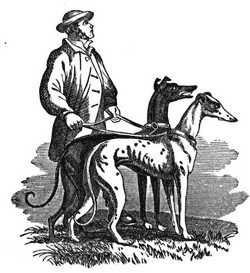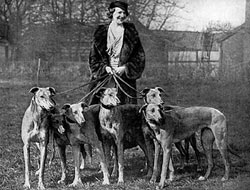Learn about Golden State Greyhound Adoption Group. |
Learn how to adopt your own family Greyhound. |
Greyhounds available now for immediate adoption. |
Where to meet a Greyhound in person. Dates and locations. |
A Greyhound owner's manual. |
Help our greyhound adoption efforts by donating today! |
Read inspiring stories about GSGA adopted greyhounds. |
Adoption photos & fun pictures of our Greyhound friends. |
From "The Odyssey" to speedy runner to loving friend. |
Articles about Greyhounds. |
More links and resources for your retired racing greyhound. |
Meet our dedicated greyhound adoption & rescue volunteer staff. |
Have questions? Let us help! Ask them here. |
YOU ARE HERE: Greyhound Dog Adoption > Greyhound Training > Breed History
Breed History of Greyhounds
No other canine is as closely associated with speed, grace, and overall agility as the greyhound. For millennia greyhounds have been cherished and bred as hunting dogs whose keen ability to spot prey and it's movement, using their keen sense of sight, and to purse and capture that game at incredibly fast speeds, that have endeared the greyhounds to the most prestigious of owners throughout time., It is for their rare ability to fill this unique hunting niche and to simultaneously live as loyal devoted companions that has elevated the greyhound to the courts of kings, and rulers throughout their long history. The term greyhound may have been derived from the term grei meaning dog or hundi meaning hunter or gre meaning first rank among dogs.
Mentioned in Ancient Time
 Greyhounds have been man's companions for such a long period of time that they are even mentioned in the earliest of ancient texts, including the Bible. Experts suggest that the breed dates back about 4,000 years to the heydays kingdoms of Egypt, Greece and Persia. Greyhounds became so revered by royalty, that they were often found in depictions of royal courts, and in some cases they were even found mummified in ancient Egyptian tombs, where they were preserved as companions for their former owners in the afterlife.
Greyhounds have been man's companions for such a long period of time that they are even mentioned in the earliest of ancient texts, including the Bible. Experts suggest that the breed dates back about 4,000 years to the heydays kingdoms of Egypt, Greece and Persia. Greyhounds became so revered by royalty, that they were often found in depictions of royal courts, and in some cases they were even found mummified in ancient Egyptian tombs, where they were preserved as companions for their former owners in the afterlife.
Fast forwarding to the time of Homer, ca. 800 BCE, the greyhound features prominently in the Homer's epic, The Odyssey, when a returning Odysseus is not recognized by anyone but his trusted greyhound Argus. Having 'Argus eyes' has since become a byword to describe a person with a most keen sense of sight. During that time the depictions of ancient gods most commonly associated with hunting, the goddess Diana for example, came to include figures of hunting dogs that bear an extraordinary likeness to modern day greyhounds.
Greyhounds in the Middle Ages
 Prior to the Middle Ages, it appeared as though these swift hounds lost their place among the great halls of the privileged, especially when many famines swept the lands. Yet the resilient breed over time once again endeared themselves to royalty, and again became features in their courts.
Prior to the Middle Ages, it appeared as though these swift hounds lost their place among the great halls of the privileged, especially when many famines swept the lands. Yet the resilient breed over time once again endeared themselves to royalty, and again became features in their courts.
Moreover, the nobles became so enamored of their phenomenal hunting dogs that it was a capital offense to kill a greyhound. Human life at times was valued less than the life of one such dog. Before long, commoners were forbidden from owning these dogs, and it was only the noble who had permission from the king to own and breed greyhounds.
Greyhounds in the Age of Enlightenment & Industrialization
 As the middles ages gave way to the age of enlightenment, the status of the greyhound did not significantly shift. Although they were no longer valued above human life, they still were considered one of the premier status symbols that a man of means could aspire to. This explains their presence in many of the portraits commissioned by the wealthy and notable clientele of the famous painters of the age.
As the middles ages gave way to the age of enlightenment, the status of the greyhound did not significantly shift. Although they were no longer valued above human life, they still were considered one of the premier status symbols that a man of means could aspire to. This explains their presence in many of the portraits commissioned by the wealthy and notable clientele of the famous painters of the age.
Before long the hunt was no longer considered a worthwhile endeavor and the man of means became the man of business. While balancing ledgers and overseeing factories, the highly bred sporting dogs were put to use in the arenas of sports, where their agility once again became a highly prized asset. What may have originally been little more than a friendly competition amongst business rivals soon turned into a full fledged gaming venture; dog racing soon rivaled horse racing in popularity.
When in the past gentlemen may have consulted the horseflesh at Tattersall's, they now discussed the merits of the likes of snowball, one of the most famous racing greyhounds that impressed onlookers with an astonishing speed.
The Rising Popularity of Greyhound Racing
 England is credited with being the originating nation for modern day greyhound racing. In Hendon a mechanical device was employed to persuade six hounds to race at top speeds down a predetermined straightaway. Since this did not provide the hoped for results, operators of the racing track reverted to the use of a live jackrabbit as incentive for the hounds to race at top speed.
England is credited with being the originating nation for modern day greyhound racing. In Hendon a mechanical device was employed to persuade six hounds to race at top speeds down a predetermined straightaway. Since this did not provide the hoped for results, operators of the racing track reverted to the use of a live jackrabbit as incentive for the hounds to race at top speed.
Before long, greyhound racing ceased to be a gentleman's sport only and soon working class folks were betting alongside the magnates of industry and blue blooded lords.
California's Owen Patrick Smith brought the sport to America and in the 1900s he perfected the mechanical lure that made the demise of the jackrabbit unnecessary. The first track using Patrick's invention was in Emeryville California. Round racing tracks became the norm in the United States, then made it to England, and from there also had an introduction to Ireland as well as Australia.
A Racing Dog's Life
Living life as a racing greyhound is radically different from that of dogs that get to spend life as a pampered pooch. Puppies are kept in large kennels where they are socialized and encouraged to run. When they are three months old, they receive two tattoos, one in each ear. One identifies their date of birth while the other is an identification number that corresponds with records kept at the racing industry's headquarters, the National Greyhound Association.
Training now takes on more streamlined forms. The puppies must learn to identify the mechanical lure and then also give chase. They are trained to properly start from a crate and not become distracted by familiar and unfamiliar dogs. The entire training cycle takes about two years. At the end of this time period the greyhounds are evaluated for their ability to run the entire track in a satisfactory period of time.
The sad reality of the greyhound racing business dictates that unproductive dogs - those which are either not fast enough to win races consistently or which become hurt - are euthanized. If they fail to earn money for their kennel and owners, they have become a liability instead of an asset, and the racing business does not retain unprofitable dogs.
Thank Goodness for Greyhound Adoptions!
Fortunately there are various private groups and nonprofit organizations, such as Golden State Greyhound Adoption, that specialize in the rescue and care of retired greyhounds a well as those that are considered unprofitable. The result is thousands of Families that enjoy the company of these sleek hounds as they are now playful companions and family pets.
|
copyright © 2014 Golden
State Greyhound Adoption. Have site comments, or is something on the site
not working? Please send email to gsga@astound.net. |
